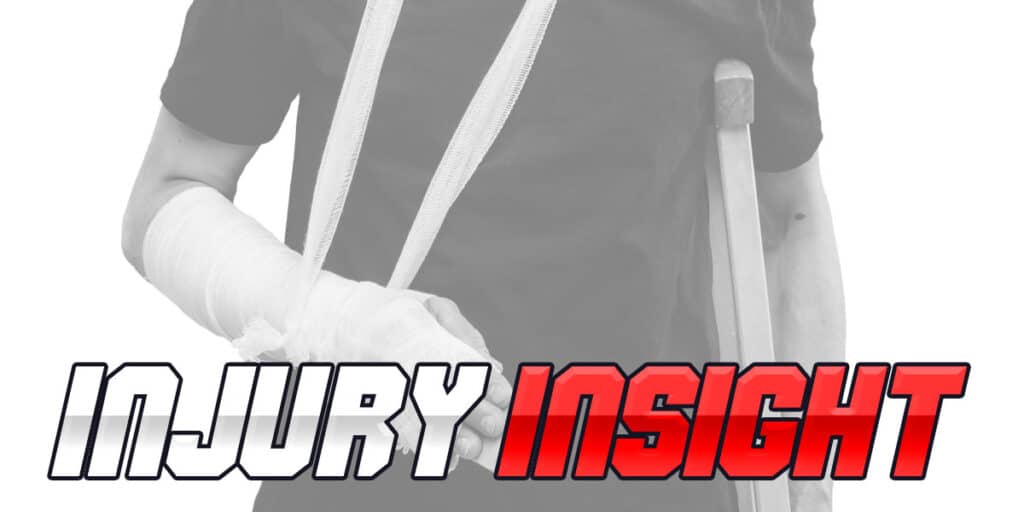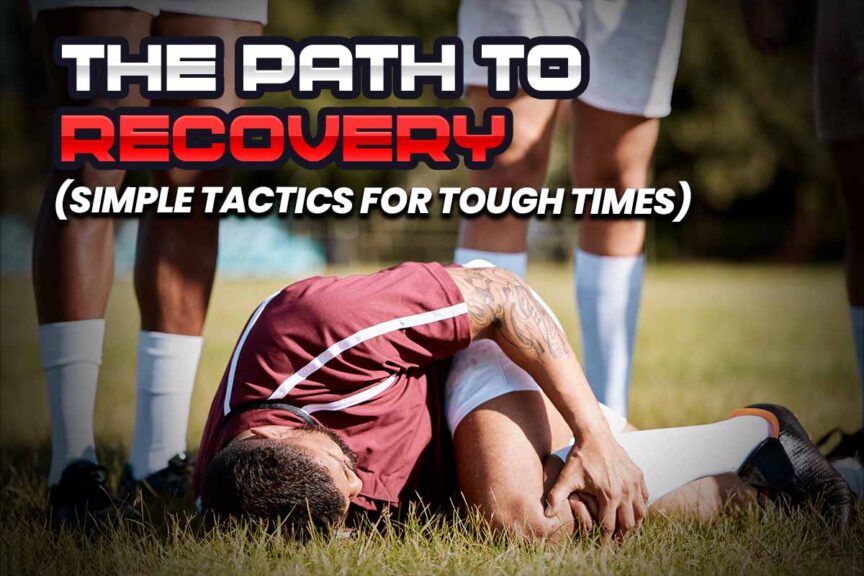If you’re currently injured, you’re not alone.
I wish I could snap my fingers and instantaneously take away pain and dysfunction from others. Believe me, as a physical therapist, nothing would make me happier than to work myself out of a job and find a new career that didn’t involve seeing others in pain.
Not because I don’t like what I do — far from it, in fact — but because I have a heart for others and don’t like seeing them in pain. In a perfect world, pain wouldn’t exist, and I’d be just fine with that; I could find plenty of other meaningful pursuits worth chasing down in this life outside the world of physical rehabilitation.
In this article, I’m going to go through profoundly helpful steps to take, and factors to consider that can help orient you in the right direction for cultivating a healthy mindset and getting you through the injury or condition you’re currently facing.
As you read through the insight below, my hope is that you can be filled with a sense of peace regarding your situation and that you’ll remind yourself that everyone loves a good comeback story!

Common ground: Experiencing pain and injury
I’m very aware that you know nothing about me, but it’s worth knowing that I know what it’s like to be injured and the dark mental roads that we can find ourselves travelling when dealing with nasty pain, be it acute pain or chronic pain.
A few years ago, I started this blog to help others navigate that world and perhaps serve as a small, humble beacon of hope for those who may need it.
So, let’s get honest about injuries; they can be a scary thing to deal with, especially when we don’t understand the nature of our injury or what the pain accompanying it means. There can be annoying pain — the type that is a nuisance but goes away after a week or two, and then there’s the stubborn pain that doesn’t seem to go away, despite what you do, or the pain that’s so intense it makes you wonder if you’ll ever get your life back.
Related content:
And that’s arguably the most challenging thing about being injured — the fact that you can’t simply put your life on pause until you get things under control and back to full health. Pain and injury don’t care whether it’s a convenient or inconvenient time to experience its presence.
Obviously, I don’t know anything about your situation and the pain or injuries you may be dealing with. But what I’d like to do here, if nothing else, is to give you some initial steps you can consider taking when dealing with these situations.
If I can help point you in the right direction before you embark on your journey of recovery or help plant some seeds of insight that can help you with a more optimal mindset, it might just be enough to help take the physical or emotional edge off of what can otherwise feel like an overwhelming issue.
So, with that preamble out of the way, let’s talk about some low-hanging fruits that you can go after that can help make a difference in taking the edge of this situation.
“The challenge of injury is you can’t simply put your life on pause until you get things under control and back to full health.”
The first tactic: Find strength in numbers
If you’re feeling physically or emotionally overwhelmed with your injury or current condition, the first step I would advocate for would be to take a deep breath, take a step back, and remember that you’re not alone in this situation.
That’s in no way an attempt to dismiss or downplay the situation you find yourself in. Rather, it’s my way of gently reminding you that pain and injuries are something that happen to us all. And simply remembering this can be profoundly helpful to those who feel like they’ve been put on an island and are stranded and alone.
I promise you that if you feel like you’re on injury island, you’re not the only individual who is inhabiting it; there are plenty of other individuals on the island who, like you, are trying to find their way back to the metaphorical mainland of their regular life.
So, keep this in mind. There’s strength in numbers, and if you need some company, there are various groups and threads online you can become a part of that can serve as an online community to help you along the way.
The second tactic: Grounded in the present
The second thing I’d advocate for would be to try your best to stay in the present. That is, to ground yourself to the current moment and not allow your mind to drift into the future and think of the seemingly infinite “what if” scenarios that it can conjure up.
This technique of staying connected to the present is often known as grounding or mindfulness. It’s a technique that can be helpful for those — like me — who struggle with anxiety and find their minds constantly looking to the future and conjuring up the unfavourable scenarios that could arise if things go terribly wrong.
If you want some solid grounding techniques that can help you to stay in the present, here’s a list of 30 grounding techniques you can try (link takes you to a Healthline article).
Becoming aware of my thought patterns and trying to pull myself back to the present has been extremely helpful for me over the years as I’ve faced my own battles of both physical and emotional variety. It can help prevent what’s known as catastrophization (link takes you to a helpful article by the National Library of Medicine), which, in the case of physical pain and injury, leads to us becoming even more sensitive and reactive to our pain or current situation.
“There are plenty of other individuals on the island of injury who, like you, are trying to find their way back to the metaphorical mainland of their regular life.“
If you’re fearful of your pain or are scared that it’s going to ruin your life, it may be worth checking out a book by David Butler and Lorimer Mosley called Explain Pain, which provides very helpful information on the world of physical pain and what it signifies. I’ll leave a link to the book below.
The third tactic: Understanding the beast
Another profoundly helpful step to take when dealing with injuries is to start educating yourself about the injury you’re up against to the best of your abilities. Education goes a much longer way than most individuals realize. It helps prevent catastrophization, helps you feel like you’ve got a sense of control over your situation, and helps you avoid making mistakes and doubling down on what you can do regarding your rehabilitation.
Whether it’s chatting with a qualified individual or utilizing helpful resources online, a basic understanding of your injury or condition is your first line of defence when formulating a battle plan to overcome what you’re up against.
Related content:
The fourth tactic: Keep Moving
Lastly, try your best to find ways to keep moving, no matter how small, gentle, or easy any movement might feel. This can be a tricky scenario to navigate, especially when you feel that everything hurts or that you don’t know what’s causing your pain. Naturally, I’d advocate that you get a professional to evaluate your condition and get some guidance. But at the end of the day, know that chronic stillness for your body can often create many new physical and emotional problems.
Related content:
Generally speaking, you don’t want your pain to worsen with any physical activities or worsen after you’ve completed them. Still, it’s important to remember that physical activity can be physical medicine for the body when given in the right amount, intensity, and frequency.
The fifth tactic: Harnessing hope
Last, but certainly not least, don’t give up hope. In my years of treating and training others, I can tell you through my anecdotal experiences that the individuals who experience the best outcomes are those who choose to find ways to consistently physically move while finding something to be grateful for within their circumstances. That can be easier said than done, but remember that if you have hope, you have hope.
Final thoughts
So, for this article, let’s start with those preceding steps. There’s so much more that needs to be addressed, but these brief bits of insight can certainly help point you in the right direction for starting to navigate the world of pain and injuries.
I’ll be typing up plenty more of these articles, so if you’re down to learn more, consider subscribing to this channel. And if you want to help spread the word about how to begin navigating the world of pain and injury, consider sharing this post with a friend so we can spread the word about how to start taking back your life and overcoming physical pain and dysfunction.
Hang tough. You’re brave, and you are strong — and I’m rooting for you!

Hi! I’m Jim Wittstrom, PT, DPT, CSCS, Pn1.
I am a physical therapist who is passionate about all things pertaining to strength & conditioning, human movement, injury prevention and rehabilitation. I created StrengthResurgence.com in order to help others become stronger and healthier. I also love helping aspiring students and therapists fulfill their dreams of becoming successful in school and within their clinical PT practice. Thanks for checking out my site!

